To continue following me, please in future read my posts on my main blog, SilverTiger.
To do so, please click on this link or scan the QR code blow:

QR code for SilverTiger

To continue following me, please in future read my posts on my main blog, SilverTiger.
To do so, please click on this link or scan the QR code blow:

QR code for SilverTiger
It’s another grey day but, thankfully, without rain (so far).

Aboard the 19
We are going to meet friends and we started by catching a number 19 bus in St John Street.

Shaftesbury Avenue
We left the bus in Shaftesbury Avenue.

China Town
We walked down Gerrard Street into China Town whose streets are filled with red lanterns.

Charing Cross Station
We made a pit stop at Charing Cross Station.
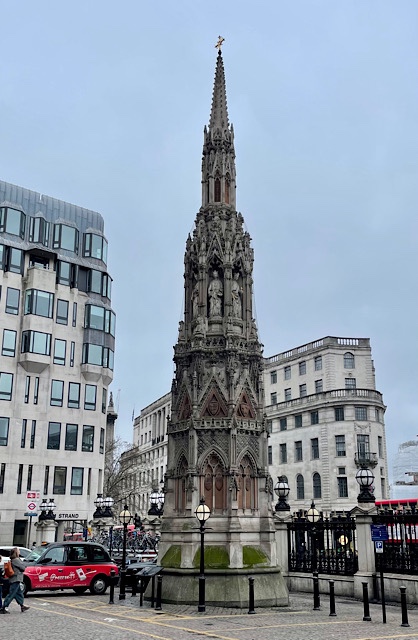
The Eleanor Cross
The “cross” part of the station’s name comes from it being the location of one of the Eleanor Crosses erected by a grieving King Edward I.

Staircase, Clermont Hotel
We were to meet our friends in the Clermont Hotel which shares the building with the station. We climbed the elegant central staircase to the first floor.

First floor corridor
In the corridor are comfortable armchairs where we were content to rest for a while as we were early for the rendezvous.

Strand
When our friends arrived, it turned out that the hotel cafe was not yet open so we left and walked along Strand.
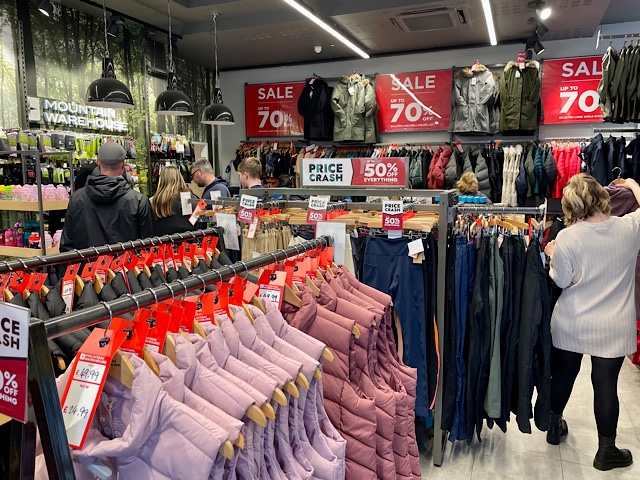
Mountain Warehouse
Our friends had some purchases to make and so we went into Mountain Warehouse and a few other shops.

Maiden Lane
We then wandered through streets around Covent Garden, such as this one, Maiden Lane.

Goodwin’s Court
We followed this passage called Goodwin’s Court.

Leicester Square
Crossing a few more streets we arrived at Leicester Square which was as busy as you would expect it to be.

Coffee and croissants
We paused for a coffee break at a branch of Ole & Steen. We of course ordered coffee and croissants!
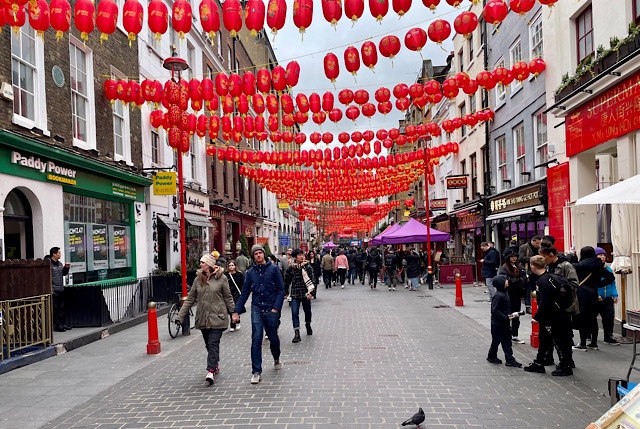
China Town revisited
Setting off once more, we again crossed through China Town.
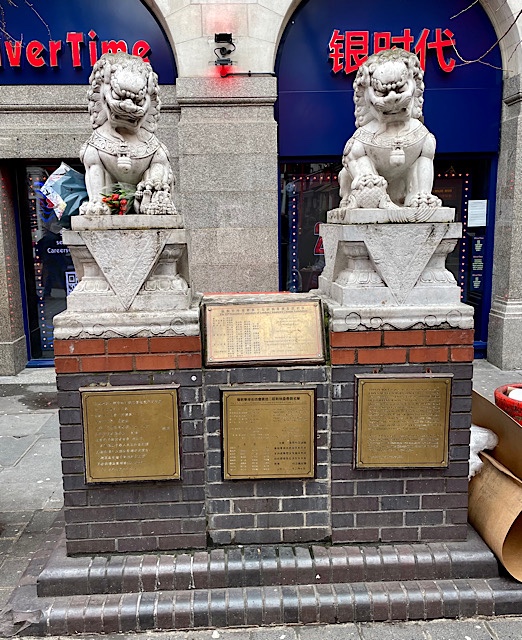
Traditional pair of Chinese Lions
I stopped to admire this pair of traditional Chinese Lions. They are always a pair of male and female. The male has a paw on a ball and the female a paw on a lion cub. The cub is upside-down, suggesting that they are playing.

Bistro 1
We were now in Soho where we stopped for lunch in a small restaurant called Bistro 1. The food was good though we did not manage to eat it all (perhaps we shouldn’t have had those croissants earlier!).

Old Compton Street
We now rambled the streets of Soho. This one is the well known Old Compton Street.

Soho Square
We passed by the also famous Soho Square with its central garden.

Église Protestante Française de Londres
Here is to be found the French Protestant Church of London. As it was closed, we could not go in but…

Door arch mouldings-
…we could admire the characterful mouldings in the door arch.
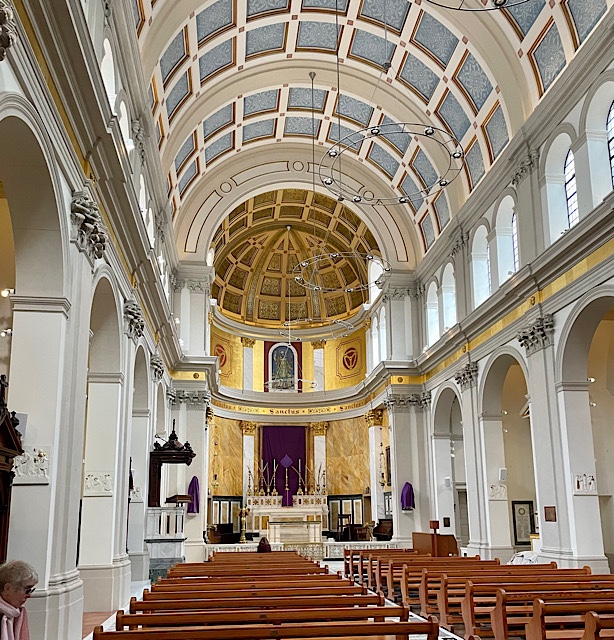
St Patrick’s Catholic Church
Nearby was St Patrick’s, this one a Catholic church. I wonder whether there is any rivalry between the two churches. We could visit this church though the figures of saints etc were veiled as is the custom at Easter.

Foyles
Returning the Charing Cross Road, we paid a visit to Foyles, possibly the most famous bookshop in the UK and perhaps even the world.

Detective fiction by Georges Simenon
I headed for the French language section and after much deliberation, chose a detective fiction novel by Georges Simenon.

Back in Ole & Steen
On leaving the bookshop, we looked for somewhere to have a last coffee together but, as you might imagine, everywhere was packed out. We arrived again at Ole & Steen and managed to grab a table upstairs.

Bus stop, Shaftesbury Avenue
We took leave of our friends in Charing Cross Road where they boarded a bus to start their journey home. We walked round to a bus stop in Shaftesbury Avenue where we could catch a number 19 bus for the Angel.

Aboard the 19
The 19 duly arrived and we occupied our favourite seats at the back for the ride home. At home, we will relax and make tea and perhaps I will start reading my new book!
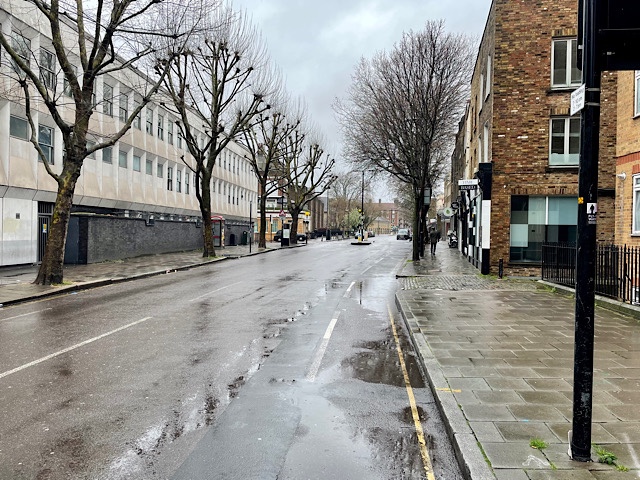
Rainy Penton Street
To judge by the look of the sky, we were promised rain for the whole day but, undaunted, we set off along Penton Street, trying to ignore the water being blown onto our faces.

Chapel Market
I needed to buy curtain hooks, so we walked along Chapel Market to the hardware shop that resides there.

Caffè Nero, Islington Green
After purchasing the hooks, we continued on to Islington Green and the branch of Caffè Nero there. We stayed there for quite a while before plucking up our courage to go on.

The bus stop
We crossed the road to the bus stop and…
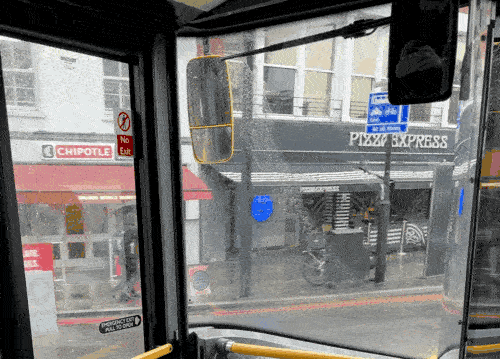
Aboard the 63
…boarded a number 63 bus.

London Bridge Bus Station
The 63 brought us to the bus terminus at London Bridge Station. We left the bus and stepped out into the rain once more.

Southwark Cathedral
We returned on foot to the main road, passing by the impressive mass of Southwark Cathedral.

Alley to Borough Market
We walked along this alley decorated with street art. It leads to what I think I am justified in calling the world famous Borough Market.
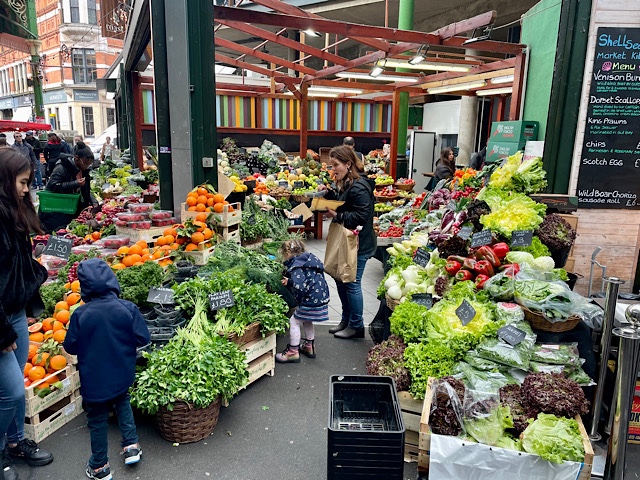
Greengrocer’s stall
Certainly, there is an amazing range of food items on display from the everyday to the exotic. Top chefs and well-heeled amateurs shop here and the place was, for my taste, unpleasantly crowded. I was glad to emerge from it on the other sside.

A barren parklet
We walked through a rather uninteresting housing estate which included this rather barren open space or “parklet”.

Tree in blossom
We did, though, pause to admire this tree in blossom.

The Tate Modern in view
I suddenly realised that we were near the Tate Modern art gallery. Tigger knew, of course, but I usually just follow her, waiting to be surprised when we arrive somewhere I wasn’t expecting!

Leon
First, though, we thought of having an early lunch as there happened to be a branch of Leon nearby.

Negotiating with the terminal
In a Leon restaurant you don’t go to the counter and tell a human what you want. Instead, you have to use a terminal rather like a giant iPad. You choose your items, give a name and pay, using a contactless payment terminal.
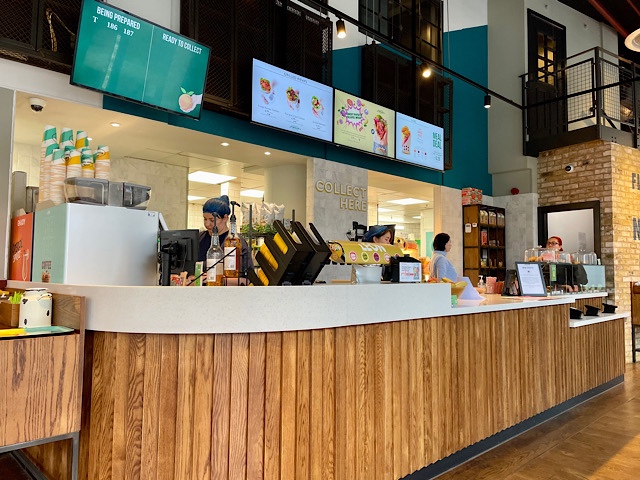
The counter
Your meal is then assembled and when it is ready, they call out the name you gave them and you collect your items from the counter.
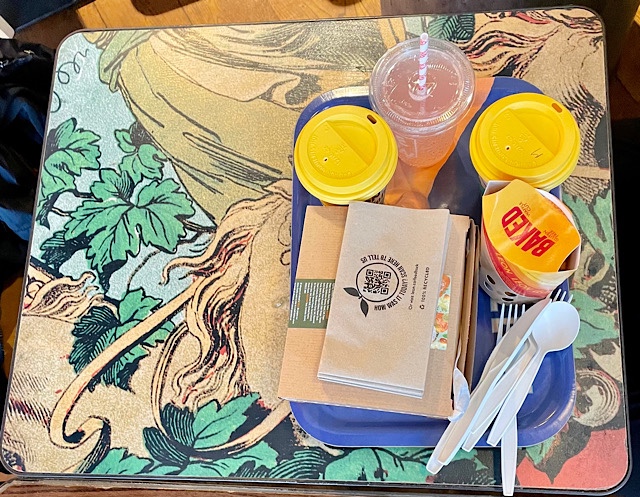
Meal on a tray
Needless to say, there are no plates or cups: everything comes in cardboard boxes or plastic containers. Cutlery is plastic and disposed of after use.

Approaching the Tate Modern
Photo by Tigger
After our lunch, we crossed to the Tate Modern. The new building rears up above you, making me think of a mountain to be climbed. Fortunately, our ambitions were more lowly and we entered via a door.

The museum shop
We had a look around the large museum shop before continuing.

The Turbine Hall
Photo by Tigger
The Tate has taken over what was once the Bankside Power Station and contains some very large galleries. The largest is the old Turbine Hall whose size allows unbelievably huge works of art to be displayed. Currently, it is holding Brain Forest Quipu by Cecilia Vicuña.
I have made no secret of my scepticism regarding modern “art” and I am not going to pretend an understanding of it that I don’t possess. I will therefore show you just a few of the items we saw with their titles and names of artists and a minimum of comment.
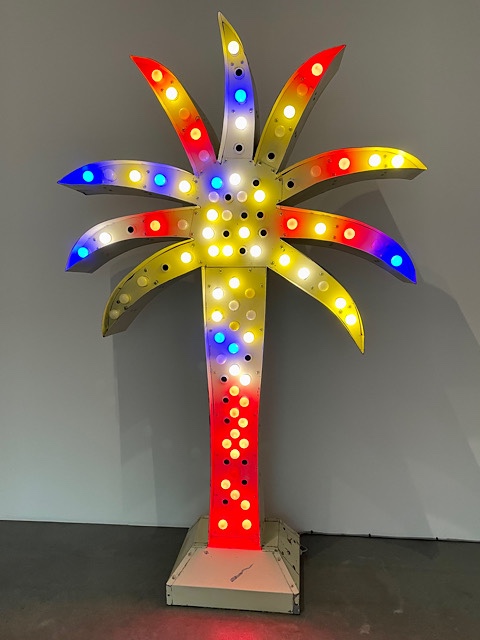
Palm Sign (2010)
Yto Barrada

Alpine Ibex (2017)
Jimmie Durham
This one amused me somewhat as it is made of an ibex skull and bits of furniture, reminding me rather of Picasso’s bull’s heads made with parts of a bicycle.
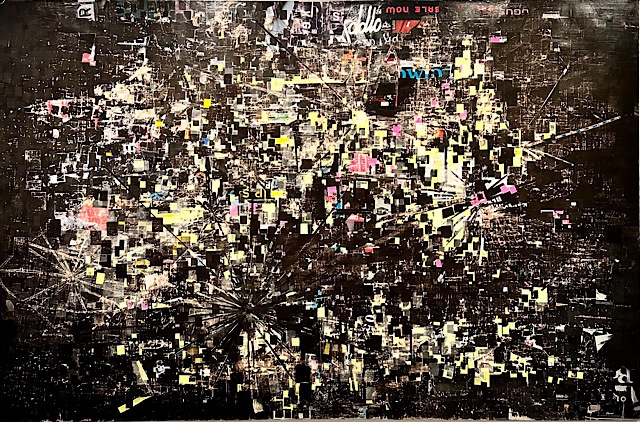
Los Moscos (2004)
Mark Bradford

Who owns what? (2012)
Barbara Kruger
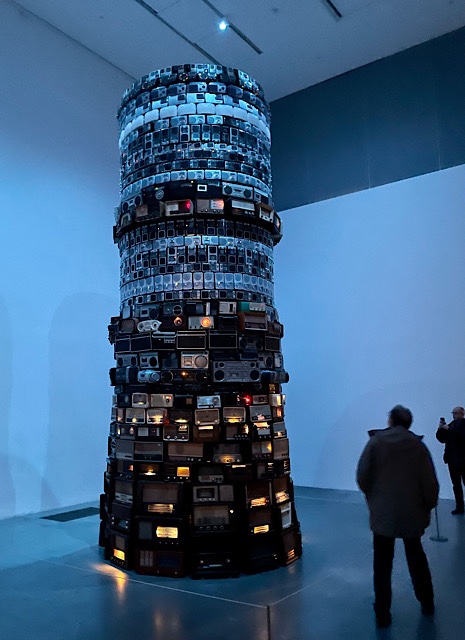
Babel (2001)
Cildo Meireles
This work, Babel, is described as “a tower of radios playing at once” and that is exactly what it is.

Pelting with rain
When we came to leave, we found the skies had opened and it was pelting with rain. There were already huge puddles everywhere. We waited a while, hoping it would ease off, but that seemed unlikely to happen. Fortunately, I had a folding umbrella in my bag and under the scanty shelter that this provided, we made a dash for the bus.
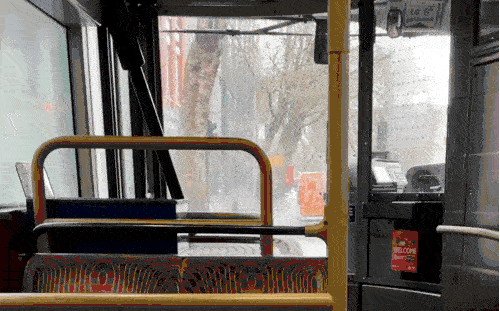
Aboard the 63
We had quite some way to go, doing our best to hide behind what was a rather small umbrella. As we reached Blackfriars Bridge, we saw our 63 bus approaching. We were still some way from the bus stop but we waved desperately at the driver and he was kind enough to stop and let us board.

Aboard the 19
At Mount Pleasant we left the 63 and walked to the bus stop in Rosebery Avenue where we caught a number 19 to complete our journey home.

Sun masked by clouds
It’s an all-sorts day, as far as weather is concerned. From time to time the sun breaks through but is then masked by clouds which ever and anon sprinkle us with rain. Sometimes there is sunshine and rain at the same time.

Myddelton’s deli
As usual, we started with fuel (aka coffee) at Myddelton’s in Amwell Street.

Bus stop, Rosebery Avenue
We then walked down to a bus stop in Rosebery Avenue where…

Aboard the 19
…we boarded a number 19 bus and found seats at the rear.

Concrete cast sculpture
We arrived after a longish ride at Duke of York’s Square where this sculpture (by whom, I know not) was advertising the current exhibition in the Saatchi Gallery.
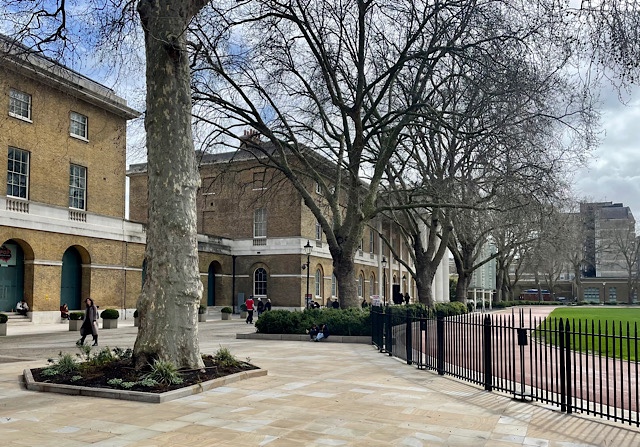
Towards the Saatchi
We had thoughts of visiting the Saatchi but then saw that, contrary to its previous policy of free entry, it was today charging £15 to go in. So we changed our plans.
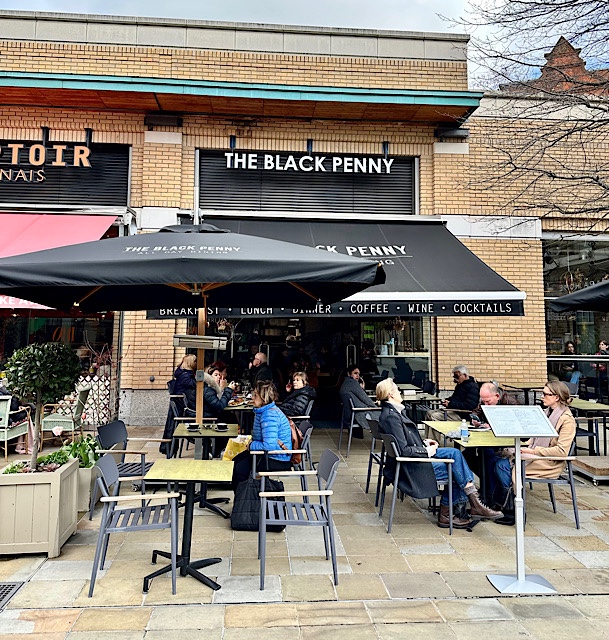
The Black Penny
Photo by Tigger

Brunch
Photo by Tigger
Nearby was a cafe called the Black Penny and we went in for an early lunch. (As it was before noon, they were still serving the breakfast menu but, call it brunch, and that was good enough for us). We had a vegetarian dish called Ozdemir Pasha.

Sloane Square
We now started a long walk to an alternative destination, starting by crossing through Sloane Square.

Trees in bloom
We saw some trees, lacking leaves but prettily in bloom.

Bicameral (2019)
Conrad Shawcross
We next encountered something that was not a tree. I find the title Bicameral mystifying but, then, modern art often doesn’t make sense.
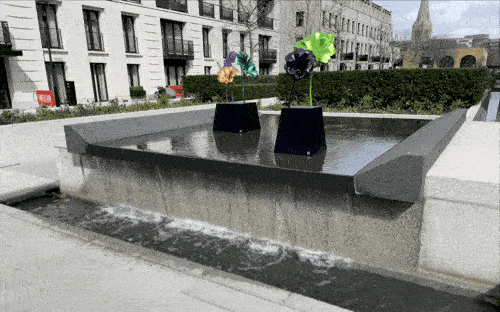
Water feature
This water feature at least had nothing pretentious about it.
We now undertook a longish walk through various districts to our alternative destination, the Tate Britain art gallery.
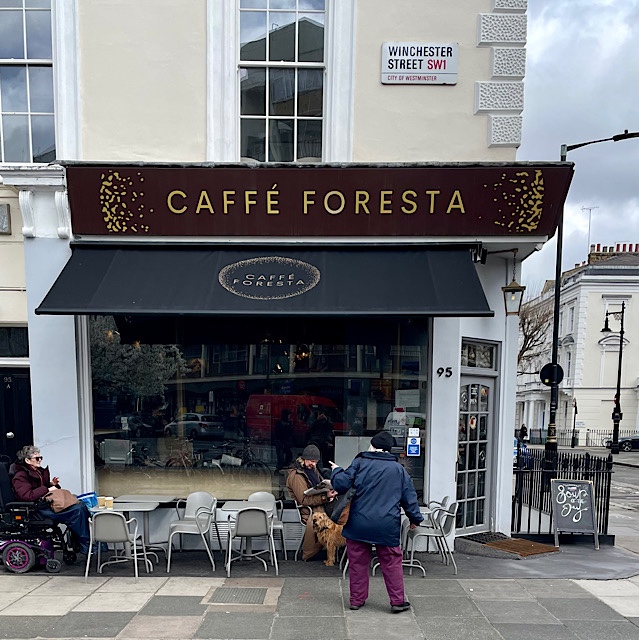
Caffé Foresta
We broke our journey in a cafe as much as to rest our legs as to take refreshment.

St Saviour’s Pimlico
Continuing on, we passed St Saviour’s Church Pimlico, an Anglo Catholic Church, whatever that is.

Cabmen’s Shelter, St George’s Square
In St George’s Square we passed by one of the 13 surviving Cabmen’s Shelters.

Arriving at the Tate Britain
We at last reached the Tate Britain and…
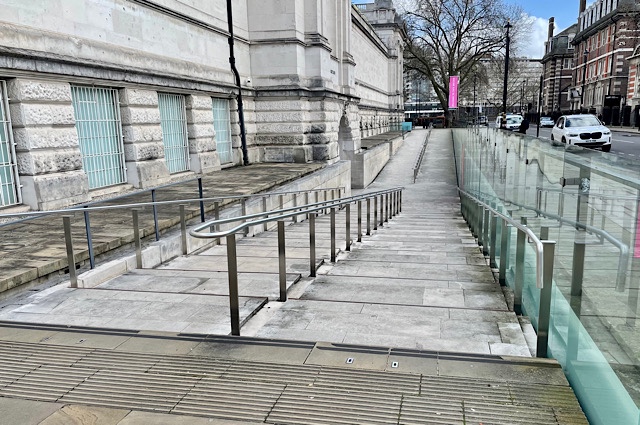
Basement entrance
…walked down the steps to its basement entrance at the rear of the building.

Crossing the Brook
J M W Turner
An art gallery of the standing of the Tate contains art of all styles and periods. Some of it – a growing amount because it is produced by modern artists – is art with which I have no sympathy whatever. I will not waste my time with it. Happily, there is plenty of art which I can enjoy and admire, the painting above by Turner being an example

Family Group (1949)
Henry Moore
I can of course show only a few of the works that I saw and liked. There is plenty more good art that I have to leave aside. Above is a piece by Henry Moore. I at first found Moore “difficult” but with time, I have come to like his sculptures more and more.

Industrial Landscape (1955)
L S Lowry
Who doesn’t like the paintings of L S Lowry? They have a deceptive simplicity but as you look at a painting, it draws you in. I feel the man himself is somehow present in the picture.

Bird (1952)
Elisabeth Frink
Elisabeth Frink is not as famous as some sculptors but you come across works of hers in many places, often in open locations.

The Visitation (1926)
Jacob Epstein
Jacob Epstein is one of my favourites. (I managed to cut off the top of her head – sorry).

Torso in Metal from ‘The Rock Drill’ (1913-5)
Jacob Epstein
This is an example of Epstein’s more “abstract” style, the sort of thing I usually don’t like but I have become familiar with this piece (I have photographed it before) and have come to feel its “presence”. Standing alone as it does, it lacks context that might make it more meaningful.

Doves 1914-5
Jacob Epstein
This one caught me by surprise as it was new to me but I immediately knew it was by Epstein and what it represented (a pair of doves). If I have favoured Epstein somewhat in this story I have at least given an idea of his versatility though I have barely scratched the surface of his work.

The Gallery Shop
We paid a quick visit to the shop, which contains a lot of interesting stock, souvenirs and luxury items as well as books and reproductions. We didn’t buy anything, though.

Tea!
Before leaving the Tate Britain, we went to the cafe and ordered tea. They serve it in small individual glass teapots where you can watch the tea as it brews. One of us had mint tea and the other, Darjeeling. Guessing who had what is left as puzzle for the reader! (Not a hard one!)
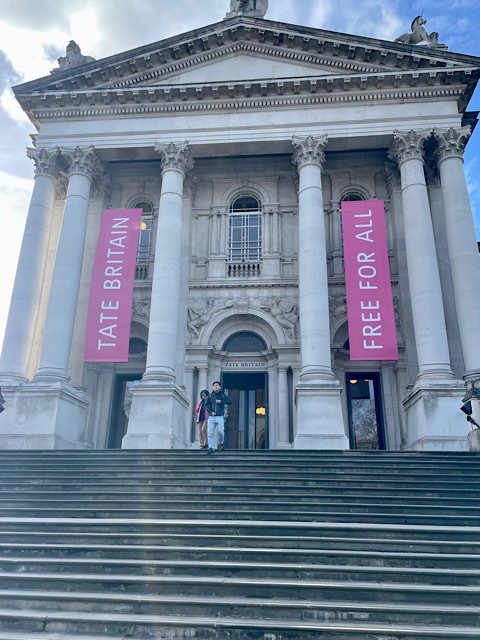
The Millbank Entrance
We left by the main portico door leading into Millbank. From there, we went round the corner and first caught a number 88 bus that deposited us in Regent’s Street,
<img src="https://tigergrowl2.files.wordpress.com/2023/03/img_0109.gif" width="640" height="486" alt="Aboard the 19“>
Aboard the 19
From Regent’s Street, we cut through to Piccadilly where we caught a number 19 bus. Traffic was heavy and the journey slow, long and tedious but we eventually reached the Angel and home where we could make tea and relax!
I expect that you, my readers – at least, most of you, anyway – will know what is meant by the “copper switch-off”. If not, then, briefly, it refers to the fact that by the end of 2025, the UK’s national telecoms provider, British Telecom, will switch off the remaining copper telephone lines. If, by then you have not moved to optical fibre for your telephone and Internet connection, you will find yourself cut off.
Exactly what is being switched off, and what will remain. is nicely explained by this useful article by Recovar.
For some years now, we have received our Internet connection from Zen. No Internet Service Provider (ISP) is perfect and we have had the occasional problems with our Zen account but, in general, they are pretty good. (When you telephone them, the recorded voice cheerfully reminds you that they are the only ISP recommmended by Which.)
Until a few days ago, we had a DSL Internet connection reaching us via BT’s copper wire telephone system. This cost us a Zen subscription of £20.40 a month but, in addition, we had to pay BT for a landline telephone connection.
As far as speed goes, Which’s broadband speed tester gave typical values of 15.1 Mbps for download and 0.8 Mbps for upload. This is quite slow by modern fibre standards but it was good enough for our modest needs and we would probably have kept it indefinitely.
Into this calm domestic scene, news of the copper switch-off erupted like the villain in the pantomime. I suddenly realised that if we sat back and did nothing, then by the end of 2025 at the latest, and probably sooner than that, our Internet connection would be cut off, never to return.
I picked up the phone (my mobile, that is, as we never use the landline to make calls and never answer it if it rings) and called Zen to ask whether they could offer a solution. They certainly could and, moreover, one that would not cost a fortune.
If you study the Recovar page mentioned above and, in particular, Figure 1 half-way down, you will observe an important fact: while the copper circuits from the telephone exchange to the “cabinet” (the green metal box in the street) are being disconnected, the copper line from the cabinet to the house will remain, at least for the time being. This meant that Zen could offer us a “fibre to cabinet” connection which will not be affected by the switch-off.
The connection from the cabinet to the house continues to run over the copper wire already in place. This means that no change is necessary at our end: we do not need a new router or even need to switch it off and on again to get it working.
Our new connection went live on March 17th. The first I knew about it was when I received an email from Zen informing me of the fact. I quickly went to the computer and started loading Web pages. Yep, we were up and running and it has run ever since without a hitch.
The copper wire connection from the cabinet means that we don’t get full fibre speed as we would with a “fibre to house” account. According to Which’s broadband speed checker, we are gettiing 30.8 Mbps download and 9.3 Mbps upload. While this is not blazingly fast, it is faster than our old connection which was already good enough for our needs.
What does our new connections cost us? It cost £30 per month. This is more expensive than our old account but, wait, there’s another advantage: we no longer need the BT phone line! We could have elected to include a Zen phone service with our contract for a few pounds more but, as I indicated above, we never used the darn thing, anyway. Paying for just the Internet connection, we are paying less than we paid before for Internet plus landline. That’s a win in anybody’s terms.
As indicated above, the changeover was seemless: I didn’t even notice it happen and the connection has gone on working as it always has but just a little bit faster.